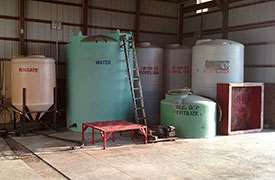By Keith Robinson
A new Purdue Extension publication gives applicators of postemergence herbicides insights into the importance of mixing herbicides with water at optimum temperatures to make them most effective.

Guidance offered in Water Temperature and Herbicide Performance is based on research by Purdue University weed scientists who studied the effectiveness of certain herbicides on several weed species when mixed with spray water at various temperatures. The researchers concluded that moderate to warm water - but not hot - was better than cold.
"We give the guidelines of not using cold water in the early spring or late fall," said Pratap Devkota, the lead researcher and graduate research assistant to weed scientist Bill Johnson. "Make sure you use moderate to warm water. The right water temperature is one of the components of herbicide application."
Farmers generally are not aware of that, Devkota said, because there has been little research on the topic.
Hot and cold
In a greenhouse study, herbicide was applied to weed species giant ragweed, marestail (horseweed), Palmer amaranth and pitted morningglory. Herbicides used were 2,4-D choline, glufosinate, mesotrione and glyphosate plus dicamba premix. Each herbicide solution was held for 24 hours and six hours before application. It also was applied immediately after mixing.
The researchers found that performance was reduced on some weed species when the herbicides were mixed with water at 41 degrees Fahrenheit, the lowest temperature tested. They also discovered that performance was reduced at 133 degrees, the highest temperature tested. Performance was not reduced at 72 and 102 degrees, the middle temperatures tested.
The study found that the herbicide mixtures held for up to 24 hours did not affect weed control in any of the tested herbicide products. The researchers cautioned, however, not to generalize the results for all herbicides. They noted previous research showing that some herbicide products from Group 2 (ALS inhibitors) can undergo hydrolysis when spray solutions remain in a tank for a certain period; likewise, herbicides in Group 1 (ACCase inhibitors) can break down when ultraviolet radiation infiltrates a tank.
Free download available
The researchers said applicators should consider that mixing certain herbicides with water warmer than 41 degrees may enhance - certainly not harm - early spring or late fall burndown applications.
They also said the temperature of water stored in tanks above ground for more than one or two days should be monitored. "It is reasonable to expect that the air temperature can give you a rough estimate of the stored water's temperature," they wrote. "You can also use a thermometer."
The researchers said further research is needed to learn the exact reasons for the lower performance of herbicides mixed with cold water. They said, for instance, it is possible that low water temperature could affect how the herbicide dissolves, the spray droplet size or herbicide penetration into the target leaf.
The publication can be downloaded free of charge through Purdue Extension's The Education Store at https://edustore.purdue.edu/item.asp?Item_Number=PPP-112. There is a charge of $5.50 for a printed copy.
Source:purdue.edu